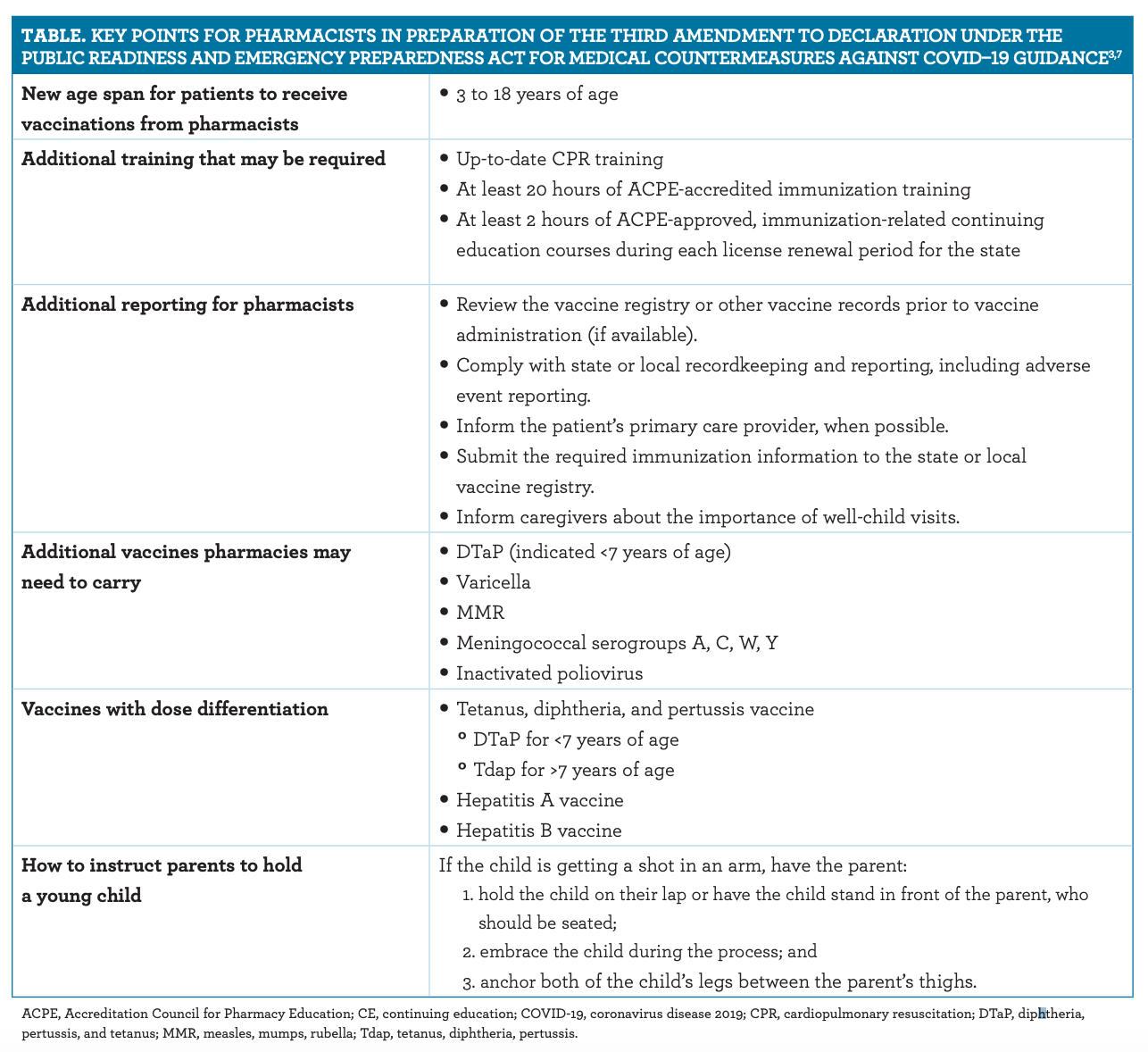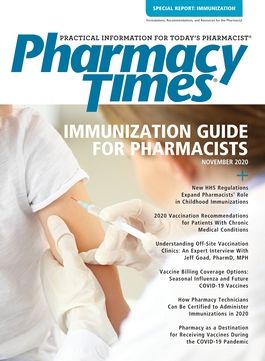Publication
Article
Supplements
New HHS Regulations Expand Pharmacists’ Role in Childhood Immunizations
Author(s):
When children miss routine vaccinations, it poses a major public health threat for increased outbreaks of preventable diseases.
Following the national emergency declaration on March 13, 2020, due to the coronavirus disease 2019 (COVID-19) pandemic, there has been a drastic drop in childhood immunizations. According to a May 2020 CDC report, 2.5 million fewer doses of vaccines were ordered through the Vaccines for Children program in 2020 compared with the same time period in 2019. The decline in vaccinations was likely related to families avoiding well-child visits due to concerns about possible exposure to SARS-CoV-2, the virus that causes COVID-19.1
When children miss routine vaccinations, it poses a major public health threat for increased outbreaks of preventable diseases.1,2 To combat this, the US Department of Health & Human Services (HHS) issued an amendment to the declaration of a national public health emergency made under the Public Readiness and Emergency Preparedness Act. On August 24, 2020, HHS expanded availability of vaccination administration options by allowing pharmacists in all states to administer vaccines to children as young as 3 years of age.3 Previously, the minimum age of a child a pharmacist could immunize was state dependent, and only 28 states permitted pharmacists to vaccinate children in general.4 The amendment also applies to pharmacy interns who are licensed or registered by their state’s Board of Pharmacy and acting under a pharmacist’s supervision.3 This amendment aims to provide additional options to help prevent outbreaks of vaccine-preventable diseases during this challenging time when stay-at-home orders are in effect and many parents are placing preventive care lower on their list of priorities.5,6 The amendment also will relieve some of the strain that pediatric offices are facing, both in trying to catch up with wellness visits missed during the peak of the pandemic and in responding to COVID-19 visits. In particular, with schools and day care facilities beginning to reopen, there may be a rise in cases of communicable diseases.
Sign up for the webinar: A Unique Siderophore Cephalosporin for the Treatment of Difficult-to-Treat Gram-negative Infectionscloud.email.pharmacytimes.com/PT_Siderophore_Cephalosporin
There are a number of important considerations for pharmacists in regard to this amendment (table3,7). When pharmacists administer vaccines to children, they have a duty to inform the child’s caregivers of the importance of a wellchild visit with their primary care provider and refer patients when appropriate.3 Any licensed pharmacist, or licensed intern under the supervision of a licensed pharmacist, is eligible to vaccinate children as young as 3 years if they meet all of the requirements. Pharmacists must have completed an Accreditation Council for Pharmacy Education (ACPE)—approved practical training program of at least 20 hours. These training programs are intended to be hands-on and contain comprehensive information on immunizations. During each state license renewal period, pharmacists also must complete a minimum of 2 hours of ACPE– approved, immunization-related continuing education courses. Lastly, they must have a current certificate in basic cardiopulmonary resuscitation. Vaccines must be ordered and administered according to the CDC’s Advisory Committee on Immunization Practices (ACIP) standard immunization schedule.3,7 Pharmacists also must comply with necessary recordkeeping and reporting requirements of the state or jurisdiction where they are practicing and administering vaccines. In summary, pharmacists must inform the patient’s primary care provider, when available; submit information to a vaccine registry or other state or local immunization information system; report adverse events; and review the vaccine registry or other relevant records prior to administering a vaccine.3

CHALLENGES WITH VACCINATING YOUNGER PATIENTS
Vaccinating a younger population brings a number of new challenges for pharmacists. The amendment likely will require pharmacies to stock child-specific vaccines that were previously unnecessary to carry (table3,7). Pharmacists also must pay close attention to the differences in dosing between children and adults. Additionally, some immunizations (eg, influenza) require a 2-dose series for vaccine-naïve patients; however, this will likely not be relevant, as most children would have received their first series of influenza vaccine at age 6 months.8 Although pharmacists have ample experience counseling parents on their child’s medications, it may take practice to become comfortable immunizing a small child and easing both their anxiety and that of their parents. The change in environment also may be an adjustment for parents, as they are likely used to the privacy of the exam room compared with that of the retail pharmacy setting. It may take time for pharmacists to achieve a similar level of comfort. The decision to allow pharmacists to provide immunizations to children was accompanied by much controversy, as the American Academy of Pediatrics (AAP) and American Medical Association vehemently opposed the amendment. AAP President Sally Goza, MD, FAAP, stated that “rather than create an unnecessary alternative method to deliver immunizations to children, our federal government should invest in the one we have: pediatricians.” In addition, the AAP stated that many pharmacies do not participate in the Vaccines for Children Program, a federal program that provides immunizations to children at no cost for families who cannot afford them, which has the potential to widen the gap in health disparity.9 Pharmacists immunizing uninsured children should make every effort to provide the immunization at no cost or refer them somewhere that is able to provide the service for free. Because the decrease in vaccination rates is a public health threat, HHS is ultimately most concerned with making pediatric vaccines more accessible, keeping vaccination rates high, and protecting children against vaccine-preventable diseases during the pandemic.
CONCLUSIONS
The new HHS amendment has expanded the ability of pharmacists to immunize children aged 3 to 18 years in all 50 states. Although this came with some controversy from various medical organizations, including the AAP,9,10 from a public health perspective, maintaining high rates of immunity to vaccine-preventable illnesses is critical, particularly as the COVID-19 pandemic continues.
ALEXANDRA HANRETTY, PHARMD, is a clinical pharmacy specialist in infectious diseases at Cooper University Health Care in Camden, New Jersey.LUCIA ROSE, PHARMD, is a clinical pharmacy specialist in infectious diseases at Cooper University Health Care in Camden, New Jersey.
REFERENCES
- Santoli JM, Lindley MC, DeSilva MB, et al. Effects of the COVID-19 pandemic on routine pediatric vaccine ordering and administration—United States, 2020. MMWR Morb Mortal Wkly Rep. 2020;69(19):591-593. doi:10.15585/ mmwr.mm6919e2
- Hoffman J. Vaccine rates drop dangerously as parents avoid doctor’s visits. The New York Times. April 23, 2020. Accessed September 30, 2020. https://www.nytimes.com/2020/04/23/health/coronavirus-measles-vaccines.html
- Third amendment to declaration under the Public Readiness and Emergency Preparedness Act for medical countermeasures against COVID—19. HHS. Accessed September 22, 2020. https://www.hhs.gov/sites/default/files/ third-amendment-declaration.pdf
- Stobbe, M. Pharmacists can give childhood shots, U.S. officials say. Associated Press. August 19, 2020. Accessed October 23, 2020. https://apnews.com/ article/6147846d7fc3e9e24c5da70d62f814de
- State “shelter-in-place” and “stay-at-home” orders. Financial Industry Regulatory Authority. Updated August 4, 2020. Accessed September 30, 2020. https://www.finra.org/rules-guidance/key-topics/covid-19/shelter-in-place
- Vaccine rates drop dangerously as parents avoid doctor’s visits. American Pharmacists Association. April 24, 2020. Accessed October 23, 2020. https:// www.pharmacist.com/article/vaccine-rates-drop-dangerously-parents-avoiddoctors-visits
- Immunization schedules. CDC. Reviewed February 3, 2020. Accessed October 1, 2020. https://www.cdc.gov/vaccines/schedules/
- Grohskopf LA, Alyanak E, Broder KR, et al. Prevention and control of seasonal influenza with vaccines: recommendations of the Advisory Committee on Immunization Practices—United States, 2020-21 influenza season. MMWR Recomm Rep. 2020;69(8):1-24. doi:10.15585/mmwr.rr6908a1
- American Academy of Pediatrics opposes HHS action on childhood vaccines; calls it ‘incredibly misguided.’ News release. American Academy of Pediatrics; August 19, 2020. Accessed September 30, 2020. https://services.aap.org/en/newsroom/news-releases/aap/2020/american-academy-of-pediatrics-opposes-hhsaction-on-childhood-vaccines-calls-it-incredibly-misguided/
- AMA opposes expanding pharmacists’ ability to provide child vaccines. News release. American Medical Association; August 21, 2020. Accessed October 23, 2020. https://www.ama-assn.org/press-center/ama-statements/ama-opposesexpanding-pharmacists-ability-provide-child-vaccines







